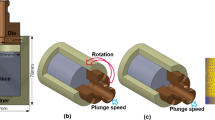Abstract
Material properties are dependent upon the microstructural characteristics of the part. Developing an accurate and sufficient representation of the microstructure obtained in metal additive manufacturing (AM) is critical to precisely estimate material properties. Since the material properties for AM parts are an important function of the welding processing parameters, a fundamental understanding of how AM components behave in load-bearing applications depends on understanding the evolution of thermal cycles and residual stresses during component fabrication. In this work, a finite-element thermo-plasticity procedure in wire + arc AM process was developed in a three-dimensional domain using the finite-element (FE) code ABAQUS. The proposed research aims to establish a methodology for characterizing directed energy deposited metals by linking processing variables to the resulting plastic strains and residual stresses. The effect of multi-layer deposition on the prediction and validation of local plastic strains and thermally induced stresses was investigated. It was found that the thermal (residual) stresses increase with either the increase of weld speed or the increase of the heat distribution parameter. On the other hand, local plastic strains increase with the increase of welding speed, but not necessarily with the increase of the heat distribution parameter. Similarly, the level of thermal stresses and local plastic strains is lower in each new successive AM layer. As a new layer is deposited over a previously heated one, the relief of thermal stresses and plastic strains occurs by preheating; the more preheated the previous layer, the less the level of thermal stresses and plastic strains in the successive deposited layer. Furthermore, the lowest level of stresses and strains observed in the last deposited AM layer, it can be solely caused by the hotter previous layer, even though the top unrestrained weldment surface is free to expand. Numerically predicted thermal stresses at different welding layers are presented for further experimental comparison. A firm foundation for thermo-mechanical modelling in wire + arc additive manufacturing process is established.







Similar content being viewed by others
References
Williams SW, Martina F, Addison AC, Ding J, Pardal G, Colegrove P (2016) Wire + arc additive manufacturing. Mater Sci Technol 32(7):641–647
Martina F, Roy MJ, Szost BA, Terzi S, Colegrove PA, Williams SW, Withers PJ, Meyer J, Hofmann M (2016) Residual stress of as-deposited and rolled wire + arc additive manufacturing Ti–6Al–4V components. Mater Sci Technol 32(14):1439–1448
Graf M, Hälsig A, Höfer K, Awiszus B, Mayr P (2018) Thermo-mechanical modelling of wire-arc additive manufacturing (WAAM) of semi-finished products. Metals 8(12):1009
Brandl E, Baufeld B, Leyens C, Gault R (2010) Additive manufactured Ti-6Al-4V using welding wire—comparison of laser and arc beam deposition and evaluation with respect to aerospace material specifications. Phys Procedia 5:595–606
Li C, Liu ZY, Fang XY, Guo YB (2018) Residual stress in metal additive manufacturing. In: 4th CIRP Conference on Surface Integrity (CSI 2018). Procedia CIRP, vol 71, pp 348–353
Megahed M, Mindt HW, N’Dri N (2016) Metal additive-manufacturing process and residual stress modeling. Integr Mater Manuf Innov 5:61
Bonifaz EA (2018) Thermo-mechanical analysis in SAE-AISI 1524 carbon steel gas tungsten arc welds. Int J Comput Mater Sci Surf Eng 7(3/4):269–287
Szost BA, Terzi S, Martina F, Boisselier D, Prytuliak A, Pirling T, Hofmann M, Jarvis DJ (2016) A comparative study of additive manufacturing techniques: residual stress and microstructural analysis of CLAD and WAAM printed Ti-6Al-4V components. Mater Des 89:559–567
Debroy T, David SA (1995) Physical processes in fusion welding. Rev Mod Phys 67(1):85–112
Brown SB, Song H (1992) Implications of three-dimensional numerical simulations of welding of large structures. Weld J 71(2):55-s–62-s
Thiessen RG, Richardson IM (2006) Metall Mater Trans B 37B:655–633
Kou S (2003) Welding metallurgy, 2nd edn. Wiley, New York
Bonifaz EA (2019) Modelling of thermal transport in wire + arc additive manufacturing process. In: Rodrigues J et al (eds) Computational science—ICCS 2019. ICCS 2019. Lecture Notes in Computer Science, vol 11539. Springer, Cham, pp 647–659
Mukherjee T, Zuback JS, Zhang W, DebRoy T (2018) Residual stresses and distortion in additively manufactured compositionally graded and dissimilar joints. Comput Mater Sci 143:325–337
Dunne F, Petrinic N (2005) Introduction to computational plasticity. Oxford University Press, Oxford
Bonifaz EA, Richards NL (2008) The plastic deformation of non-homogeneous polycrystals. Int J Plasticity 24:289–301
Bonifaz EA, Richards NL (2010) Stress–strain evolution in cast in-738 superalloy single fusion welds. Int J Appl Mech 2(4):807–826
Burnett DS (1988) Finite element analysis: from concepts to applications. Addison-Wesley Publishing Company, Boston
ABAQUS 6.14.2 (2014) Finite Element Software. Simulia ABAQUS® Inc
Bonifaz EA, Richards NL (2009) Modeling cast In-738 superalloy gas-tungsten-arc- welds. Acta Mater 57:1785–1794
Author information
Authors and Affiliations
Corresponding author
Additional information
Publisher’s Note
Springer Nature remains neutral with regard to jurisdictional claims in published maps and institutional affiliations.
Rights and permissions
About this article
Cite this article
Bonifaz, E.A., Palomeque, J.S. A mechanical model in wire + Arc additive manufacturing process. Prog Addit Manuf 5, 163–169 (2020). https://doi.org/10.1007/s40964-020-00112-y
Received:
Accepted:
Published:
Issue Date:
DOI: https://doi.org/10.1007/s40964-020-00112-y




